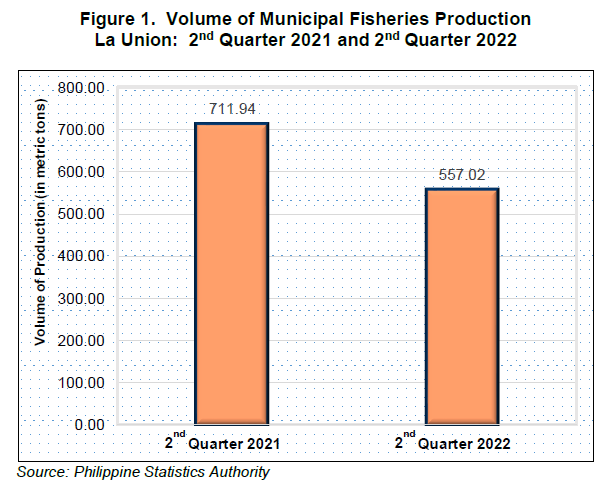La Union’s municipal fisheries production declines in 2nd Quarter 2022
The total municipal fisheries production in La Union decreased by 21.76 percent from the estimated production of 711.94 metric tons in 2nd quarter 2021 to 557.02 metric tons in 2nd quarter 2022.

Of the total volume of production for municipal fisheries, 88.71 percent came from marine municipal fisheries while 11.29 percent from inland municipal fisheries.
Marine Municipal
The volume of production from marine municipal fisheries dropped by 23.74 percent from 647.93 metric tons in 2nd quarter 2021 to 494.13 metric tons in 2nd quarter 2022.

The dominant catch in marine municipal fisheries of the province during the 2nd quarter 2022 were Squid (Pusit) with 76.68 metric tons (15.52%), Yellowfin Tuna (Tambakol/Bariles) with 55.30 metric tons (11.19%), Blue Crab (Alimasag) with 48.44 metric tons (9.80%), Slipmouth (Sapsap) with 41.90 metric tons (8.48%), and Hairtail (Espada) with 41.21 metric tons (8.34%).

Inland Municipal
The volume of production from inland municipal fisheries went down by 1.75 percent from 64.01 metric tons in 2nd quarter 2021 to 62.89 metric tons in 2nd quarter 2022.

The top five major catch in the province in 2nd quarter 2022 were Tilapia with 19.97 metric tons (31.75 percent share), Oyster (Talaba) with 7.58 metric tons (12.05 percent share), Mullet (Kapak) with 6.30 metric tons (10.02 percent share), Freshwater Shrimp (Hipon) with 5.78 metric tons (9.19 percent share), and Freshwater Crab (Talangka) with 5.75 metric tons (9.14 percent share).

Municipal fisheries data were gathered from administrative records of the Philippine Fisheries Development Authority (PFDA), Local Government Unit (LGU) - managed landing centers, and traditional landing centers.
TECHNICAL NOTES
Inland Municipal Fishing – the catching of fish, crustaceans, mollusks and other aquatic animals and plants in inland waters like lakes, rivers, dams, marshes, etc. using simple gears and fishing boats some of which are non-motorized with a capacity of less than three (3) gross tons, or fishing not requiring the use of fishing boats.
Landing Center is a place where the fish catch and other aquatic products are unloaded and traded. Traditional landing center is a type of landing center where fishermen could unload their catch and/or dock their fishing boats without any obligation or payment for the use of the place.
Quarterly Inland Fisheries Survey is a survey on volume and price of fish by species, caught by households engaged in inland fishing. It gathers quarterly data with monthly catch from sample fishing households. Respondents are fishermen or any knowledgeable member of the sample household.
Quarterly Municipal Fisheries Survey (Traditional Landing Center) – is a survey on volume and price of fish, by species, unloaded by fishing boats three (3) gross tons or less. It gathers quarterly data for the entire sample landing center with information on monthly fish unloading.
Quarterly Municipal Fisheries Survey (Philippine Fisheries Development Authority (PFDA), Local Government Units (LGUs), Privately-Managed Landing Centers) is gathering of data on volume and price of fish from administrative records of Philippine Fisheries Development Authority (PFDA) and Local Government Units (LGU)-managed landing centers. It is done on a quarterly basis with information from three (3) month period.
SGD. DANITES E. TEÑIDO, Ph.D.
Chief Statistical Specialist
/MAQ/MFC

